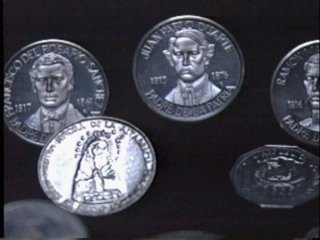The
Numismatic history of the Dominican Republic
The
indigenous communities seated in the Spanish Island or Hispaniola, located
in the center of the Archipelago of the biggest Antilles, didn't know the
uses and functions of the coin. This fact has become one of the basic
differential factors in front of other countries of the world, that they
used seeds of cocoa, perforated shells, leaves of coca, braided cotton or
other objects in its commercial transactions by means of the direct
exchange.
 The
first circulating coins in the New World were brought by the discoverers
and European settlers that arrived to our beaches at the end of the XV
Century.
The
first circulating coins in the New World were brought by the discoverers
and European settlers that arrived to our beaches at the end of the XV
Century.
The installation of a coin house in the New World are
contained in the file of instructions given by the Catholic Kings to the
Admiral Don Christopher Columbus, in 1497, before undertaking its third
trip to the Western India. In these there were expressed orders of coining
similar coins to those of the Spanish Kingdom with the gold extracted in
India; which made the Hispaniola Island the most important point in the
European outpost in America and, consequently of the civilization.
In the years of the first quarter of the XVI Century,
appear the first protests for the lack of it's own coin that facilitated
the commercial development. To that which Don Christopher de Tapia
informed to the Spanish Court that: "because of not having coin,
license is sent to work coins of gold and silver to buy goods for the
production of sugar and other", which was carried out and then
discontinued for the continuous losses of the money by cause of pirates
and bad administrations.
Later on were coined in the city of Burgos two million
maravedíes, in fleece and silver coins.
The marauding smugglers of the northern coasts
introduced coins of the most diverse countries in Europe, which were
frequently used between them and the inhabitants of the area.
Starting from 1856, the commercial development of the
country was subject to the national bill, next to the Mexican coins of
silver, staying this abnormality until final of the XIX Century. The coins
of gold also circulated, for almost all the countries of America and
Western Europe.
Before Columbus, America used grains of cacao like
commercial units of exchange were used. In 1555, the viceregal authority
of New Spain compared the real one from silver to 140 grains of cacao. The
use of this "earth currency" lasted until well entered the XIX
century.
To The Spaniard, the first European colony of the
American Continent, it corresponds to us the privilege of having had the
first coins: these circulated with exclusivity character in our world.
With the ascent of Trujillo to power, in 1930, a new
political order was glimpsed that leaving from the cult to its personality.
It impacted positively in the economic development and to the
modernization of the country. It stimulated the development of most of the
lines that composed the economic and social activities of the Dominicans.
The National Monetary System was reorganized. In 1947,
the Central Bank of the Dominican Republic, the institution that would
regulate the monetary emissions in its successive was founded.
During
the three consecutive periods of Balaguer, substantial innovations were
introduced in the monetary field. Beginning with substituting the silver
for the cupro-nickel in the coinage of the fractional coins and to emit
commemorative coins of events of national and international fame. Besides
being promulgated, a Law that modifies the definition of the weight gold
of the Dominican Republic in function of the gold, with equivalence of
0.736662 grams of fine gold. This new law continues maintaining the
official equivalence of the peso gold with the North American dollar, but
it eliminated the gold with common denominator between the parity of our
weight and the foreign coins, instituting in its place the coin of the
United States of North America. The coin is part of the history and the
culture is not only product of economic, social conditions and certain
politicians, but rather also, as a sign of the money, it has influenced in
the development of the society.